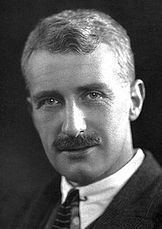Nationality United Kingdom Name Archibald Hill | Spouse Margaret Keynes (m. 1913) | |
 | ||
Born 26 September 1886Bristol, England ( 1886-09-26 ) Institutions Cambridge UniversityUniversity of ManchesterUniversity College, London Notable students Bernard C. AbbottTe-Pei FengRalph H. FowlerBernard Katz Children David Keynes Hill, Maurice Hill, Polly Hill, Janet Humphrey Books First and Last Experiments in Muscle Mechanics Similar People Otto Fritz Meyerhof, Bernard Katz, Charles Scott Sherrington, Henry Hallett Dale, Ulf von Euler | ||
Archibald Hill
Archibald Vivian Hill (26 September 1886 – 3 June 1977), known as A. V. Hill, was an English physiologist, one of the founders of the diverse disciplines of biophysics and operations research. He shared the 1922 Nobel Prize in Physiology or Medicine for his elucidation of the production of heat and mechanical work in muscles.
Contents

Biography
Born in Bristol, he was educated at Blundell's School and graduated from Trinity College, Cambridge as third wrangler in the mathematics tripos before turning to physiology. While still an undergraduate at Trinity College, he derived in 1909 what came to be known as the Langmuir equation (see Langmuir adsorption model (Langmuir 1918.). This is closely related to Michaelis-Menten kinetics. In this paper, Hill's first publication, he derived both the equilibrium form of the Langmuir equation, and also the exponential approach to equilibrium. The paper, written under the supervision of John Newport Langley, is a landmark in the history of receptor theory, because the context for the derivation was the binding of nicotine and curare to the "receptive substance" of skeletal muscle endplates.
Hill made many exacting measurements of the physics of nerves and muscles. His earliest experiments on the heat production of contracting muscles used equipment obtained from the Swedish physiologist Magnus Blix. Both before and after World War I he worked on a range of topics in physiology in co-operation with colleagues in Cambridge, Germany and elsewhere.
Hill is regarded, along with Hermann Helmholtz, as one of the founders of biophysics.
In 1914, at the outbreak of World War I, Hill joined the British army and assembled a team working on ballistics and operations research. The team included many notable physicists including Ralph H. Fowler, Douglas Hartree and Arthur Milne.
Hill returned to Cambridge in 1919 before taking the chair in physiology at the Victoria University of Manchester in 1920 in succession to William Stirling. Parallelling the work of German Otto Fritz Meyerhof, Hill elucidated the processes whereby mechanical work is produced in muscles. The two shared the 1922 Nobel Prize in Physiology and Medicine for this work.
In 1923 he succeeded Ernest Starling as professor of physiology at University College, London, a post he held until his retirement in 1951. He used to keep a toy figure of Adolf Hitler with a movable saluting arm, in gratitude for all the scientists Germany had expelled and who were now working with him.
He was President of the Marine Biological Association from 1955 to 1960. He continued work as an active researcher until 1966.
World War II saw the beginning of Hill's extensive public service. Already in 1935 he was working with Patrick Blackett and Sir Henry Tizard on the committee that gave birth to Radar. In 1933, he became with Lord Beveridge and Lord Rutherford a founder member and vice-president of the Academic Assistance Council (which became the Society for the Protection of Science and Learning in 1936). By the start of the Second World War, the organisation had saved 900 academics (18 of whom went on to win Nobel Prizes) from the Nazi persecution. He served as an independent Member of Parliament (MP) for Cambridge University from 1940 to 1945. He took part in many scientific missions to the US.
Personal life
In 1913 he married Margaret Keynes (1885-1974), daughter of the economist John Neville Keynes, and sister of the economist John Maynard Keynes and the surgeon Geoffrey Keynes. They had two sons and two daughters:
Honours and awards
Blue plaque
On 9 September 2015 an English Heritage Blue plaque was erected at Hill's former home, 16 Bishopswood Road, Highgate, where he had lived from 1923-1967. Since then the house had been divided into flats and owned by Highgate School, where Hill was a Governor from 1929-1960. It has now been sold, redeveloped and renamed as Hurstbourne. In Hill's time, according to his grandson Nicholas Humphrey, regular guests at the house included 18 exiled Nobel laureates, his brother-in-law, the economist John Maynard Keynes, and friends Stephen Hawking and Sigmund Freud. After-dinner conversations in the drawing room would inevitably involve passionate debates about science or politics. “Every Sunday we would have to attend a tea party at grandpa’s house and apart from entertaining some extraordinary guests, he would devise some great games for us, such as frog racing in the garden or looking through the lens of a (dissected) sheep’s eye.” Sir Ralph Kohn FRS who proposed the Blue plaque, said: “The Nobel Prize winner A. V. Hill contributed vastly to our understanding of muscle physiology. His work has resulted in wide-ranging application in sports medicine. As an outstanding Humanitarian and Parliamentarian, he was uncompromising in his condemnation of the Nazi regime for its persecution of scientists and others. A. V. Hill played a crucial role in assisting and rescuing many refugees to continue their work in this country.”
Publications
By Hill:
